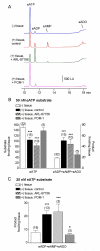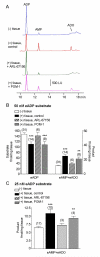A commonly used ecto-ATPase inhibitor, ARL-67156, blocks degradation of ADP more than the degradation of ATP in murine colon
- PMID: 27060478
- PMCID: PMC5002237
- DOI: 10.1111/nmo.12836
A commonly used ecto-ATPase inhibitor, ARL-67156, blocks degradation of ADP more than the degradation of ATP in murine colon
Abstract
Background: Adenosine 5'-triphosphate (ATP) is released extracellularly as a neurotransmitter and an autocrine or paracrine mediator in numerous systems, including the gastrointestinal tract. It is rapidly degraded to active and inactive metabolites by membrane-bound enzymes. Investigators frequently use inhibitors of ATP hydrolysis such as ARL-67156 and POM-1 to suppress the catabolism of ATP and prolong its effects in pharmacological studies. Our aim was to investigate directly the effects of ARL-67156 and POM-1 on the degradation of ATP and adenosine 5'-diphosphate (ADP) in mouse colonic muscles.
Methods: The degradation of ATP and ADP was evaluated by superfusing tissues with 1,N(6) -etheno-ATP (eATP) and 1,N(6) -etheno-ADP (eADP) as substrates and monitoring the decrease in substrate and increase in products (i.e., eADP, eAMP, and e-adenosine) by high-performance liquid chromatography techniques with fluorescence detection. Relaxation responses to etheno-derivatized and non-derivatized ATP and ADP were examined in isometric tension experiments.
Key results: ARL-67156 inhibits the degradation of ADP but not of ATP, whereas POM-1 inhibits the degradation of ATP but not of ADP in murine colonic muscles. Consequently, ARL-67156 enhances relaxation responses to both ATP and ADP, whereas POM-1 reduces relaxation to ATP and does not affect relaxation to ADP.
Conclusions & inferences: Studies that use ARL-67156 to inhibit ATP degradation in smooth muscle likely evaluate responses to accumulated ADP rather than ATP. POM-1 appears to be a more selective inhibitor of ATP degradation in the mouse colon. The choice of pharmacological tools in studies on extracellular ATP signaling may affect the interpretation of experimental data in functional studies.
Keywords: ADP; ARL-67156; ATP; ATP degradation; POM-1; colon; nucleotidases.
© 2016 John Wiley & Sons Ltd.
Figures





Similar articles
-
Assessment of ATP metabolism to adenosine by ecto-nucleotidases carried by tumor-derived small extracellular vesicles.Purinergic Signal. 2025 Apr;21(2):339-352. doi: 10.1007/s11302-024-10038-7. Epub 2024 Jul 27. Purinergic Signal. 2025. PMID: 39066830 Free PMC article.
-
Specificity of the ecto-ATPase inhibitor ARL 67156 on human and mouse ectonucleotidases.Br J Pharmacol. 2007 Sep;152(1):141-50. doi: 10.1038/sj.bjp.0707361. Epub 2007 Jul 2. Br J Pharmacol. 2007. PMID: 17603550 Free PMC article.
-
Assessment of ATP Metabolism to Adenosine by Ecto-Nucleotidases Carried by Tumor-Derived Small Extracellular Vesicles.Res Sq [Preprint]. 2024 Jan 24:rs.3.rs-3876953. doi: 10.21203/rs.3.rs-3876953/v1. Res Sq. 2024. Update in: Purinergic Signal. 2025 Apr;21(2):339-352. doi: 10.1007/s11302-024-10038-7. PMID: 38343828 Free PMC article. Updated. Preprint.
-
Role of Ca2+ in Mediating Plant Responses to Extracellular ATP and ADP.Int J Mol Sci. 2018 Nov 14;19(11):3590. doi: 10.3390/ijms19113590. Int J Mol Sci. 2018. PMID: 30441766 Free PMC article. Review.
-
Anion Receptors for the Discrimination of ATP and ADP in Biological Media.Chempluschem. 2021 Jan;86(1):59-70. doi: 10.1002/cplu.202000567. Epub 2020 Oct 15. Chempluschem. 2021. PMID: 33058508 Review.
Cited by
-
Involvement of purinergic signalling in the vasomotor response to hypochlorous acid in porcine coronary artery.Purinergic Signal. 2025 Apr 16. doi: 10.1007/s11302-025-10086-7. Online ahead of print. Purinergic Signal. 2025. PMID: 40238052
-
Extracellular metabolism of the enteric inhibitory neurotransmitter β-nicotinamide adenine dinucleotide (β-NAD) in the murine colon.J Physiol. 2020 Oct;598(20):4509-4521. doi: 10.1113/JP280051. Epub 2020 Aug 13. J Physiol. 2020. PMID: 32735345 Free PMC article.
-
Characterization of the N6-etheno-bridge method to assess extracellular metabolism of adenine nucleotides: detection of a possible role for purine nucleoside phosphorylase in adenosine metabolism.Purinergic Signal. 2020 Jun;16(2):187-211. doi: 10.1007/s11302-020-09699-x. Epub 2020 May 4. Purinergic Signal. 2020. PMID: 32367441 Free PMC article.
-
Loss of nitric oxide-mediated inhibition of purine neurotransmitter release in the colon in the absence of interstitial cells of Cajal.Am J Physiol Gastrointest Liver Physiol. 2017 Nov 1;313(5):G419-G433. doi: 10.1152/ajpgi.00045.2017. Epub 2017 Jul 13. Am J Physiol Gastrointest Liver Physiol. 2017. PMID: 28705804 Free PMC article.
-
Urothelial purine release during filling of murine and primate bladders.Am J Physiol Renal Physiol. 2016 Oct 1;311(4):F708-F716. doi: 10.1152/ajprenal.00387.2016. Epub 2016 Jul 27. Am J Physiol Renal Physiol. 2016. PMID: 27465992 Free PMC article.
References
MeSH terms
Substances
Grants and funding
LinkOut - more resources
Full Text Sources
Other Literature Sources

